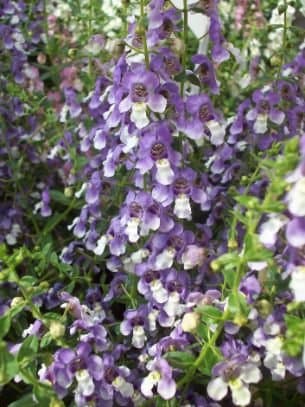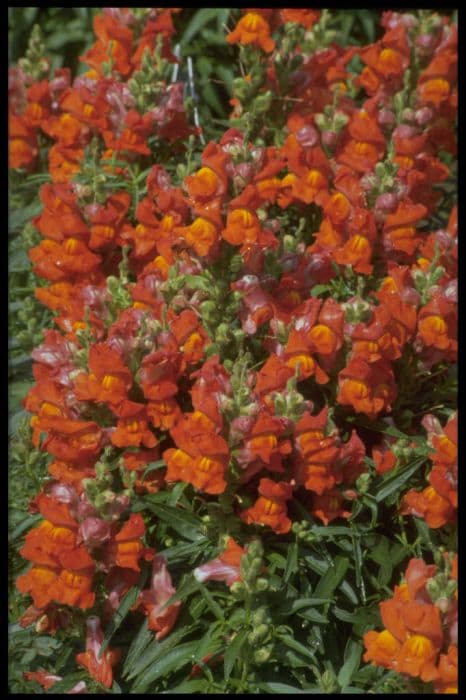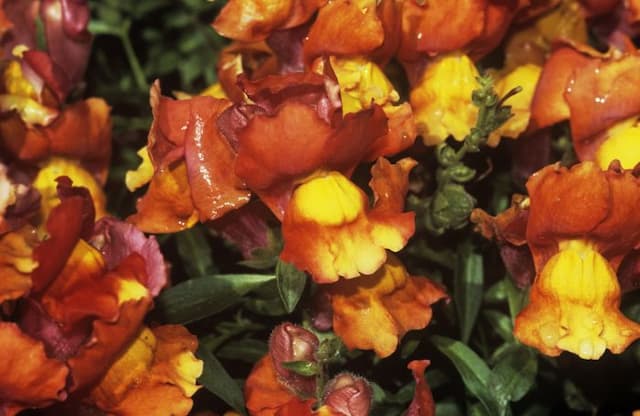Emerald Gem Hebe Hebe 'Emerald Gem'

ABOUT
Hebe 'Emerald Gem' is an attractive evergreen shrub known for its compact and rounded growth habit. The plant boasts dense, glossy foliage that takes on a deep emerald green hue, which remains vibrant throughout the year. The leaves are small, succulent-like, and spear-shaped with a smooth texture that adds to the plant’s overall lush appearance. During the flowering season, Hebe 'Emerald Gem' produces an abundance of blooms. The flowers are often arrayed in short spikes at the tips of the branches. They typically exhibit shades of white to very pale lavender, which stands out against the dark green foliage. These blossoms can attract various pollinators, adding a dynamic element to the plant’s display. The growth habit of Hebe 'Emerald Gem' is tidy, which makes it a popular choice for gardeners looking to maintain a neat and structured landscape without constant pruning. The visual impact of this Hebe variety is one of well-defined form and year-round color, making it an excellent selection for borders, low hedges, or as a specimen plant in garden beds. Its resilience and evergreen nature also make it a favored choice for container planting, where its vivid foliage can bring life to patios or balconies.
About this plant
 Names
NamesFamily
Plantaginaceae.
Synonyms
Emerald Gem Hebe, Shrubby Veronica.
Common names
Hebe 'Emerald Gem'.
 Toxicity
ToxicityTo humans
Hebe 'Emerald Gem' is generally considered non-toxic to humans. There is no significant risk associated with touching or ingesting this plant, and it is not known to cause poisoning or adverse health effects.
To pets
Similar to its profile for humans, Hebe 'Emerald Gem' is also generally recognized as non-toxic to pets. It is not expected to cause serious illness or symptoms of poisoning in animals if they ingest parts of the plant.
 Characteristics
CharacteristicsLife cycle
Perennials
Foliage type
Evergreen
Color of leaves
Green
Flower color
White
Height
1 foot 6 inches (45 cm)
Spread
1 foot 6 inches (45 cm)
Plant type
Shrub
Hardiness zones
8
Native area
New Zealand
Benefits
 General Benefits
General Benefits- Easy to Grow: The plant is known for being low-maintenance and easy to care for, which is ideal for both experienced and novice gardeners.
- Drought Tolerant: Once established, it has a good tolerance to drought, reducing the need for frequent watering.
- Evergreen Foliage: Hebe 'Emerald Gem' provides year-round greenery and structure to gardens with its evergreen leaves.
- Compact Size: It grows to a moderate size, making it suitable for small gardens, borders, and containers.
- Attracts Wildlife: Flowers can attract bees, butterflies, and other pollinating insects, promoting biodiversity in the garden.
- Long Flowering Period: It has a relatively long flowering period which adds extended interest and color to garden spaces.
- Low Hedging: Due to its dense growth habit, it can be used for low hedges or garden edging.
- Seasonal Interest: The plant offers seasonal interest with its foliage and flowers, particularly in the spring and summer months.
- Adaptable: This variety of Hebe adapts well to a variety of soil types, as long as there is good drainage.
 Medical Properties
Medical PropertiesThis plant is not used for medical purposes.
 Air-purifying Qualities
Air-purifying QualitiesThis plant is not specifically known for air purifying qualities.
 Other Uses
Other Uses- Miniature Bonsai: The compact nature of Hebe 'Emerald Gem' makes it an ideal candidate for creating miniature bonsai trees, catering to enthusiasts of the bonsai art form who prefer evergreen varieties.
- Photography Prop: Due to its lush, deep green foliage, Hebe 'Emerald Gem' can be used as a background or a prop in macro and nature photography, providing a rich texture and color.
- Educational Tool: Botany teachers can use Hebe 'Emerald Gem' to teach students about plant structure, leaf arrangements, and evergreen plant characteristics in educational settings.
- Cold Weather Indicator: As an evergreen, Hebe 'Emerald Gem' may show signs of stress, like browning or wilting leaves, in extreme cold, thereby serving as a rudimentary thermometer for gardeners.
- Fairy Gardens: With its compact growth habit, this plant can be used to create enchanting fairy gardens, providing a perfect setting for imaginative play or decorative purposes.
- Living Sculptures: Creative gardeners or artists can shape Hebe 'Emerald Gem' into various forms, like spirals or balls, to create living sculptures that add a unique aesthetic to gardens or patios.
- Feng Shui: Hebe 'Emerald Gem' might be employed in the practice of Feng Shui, contributing to the balance of energy in home gardens or interior spaces as an element of 'living' decor.
- Craft Material: The sturdy stems and foliage can be used in crafting, like making wreaths or garlands, for seasonal decor or special events.
- Model Landscaping: Model train set enthusiasts or architects can use Hebe 'Emerald Gem' to add realism to their landscapes, mimicking larger trees or bushes on a smaller scale.
- Green Roof Planting: Due to its hardiness and low maintenance, Hebe 'Emerald Gem' can be used in green roof installations, aiding urban biodiversity and insulating buildings.
Interesting Facts
 Feng Shui
Feng ShuiThe Hebe plant is not used in Feng Shui practice.
 Zodiac Sign Compitability
Zodiac Sign CompitabilityThe Hebe plant is not used in astrology practice.
 Plant Symbolism
Plant Symbolism- Youthful Vitality: Hebe is the Greek goddess of youth, and the plant named after her symbolizes eternal youth and the freshness of life.
- Evergreen Beauty: With its year-round foliage, 'Emerald Gem' represents continuous beauty and the unwavering nature of love.
- Rejuvenation: Its lush, vibrant leaves are often associated with the rejuvenating power of nature and the ability to renew oneself.
- Protection: The dense nature of this shrub suggests a symbolism of shelter and protection, offering a haven for birds and beneficial insects.
 Water
WaterThe Veronica plant, commonly known as Hebe 'Emerald Gem', requires consistent moisture but does not like to be waterlogged. It should be watered deeply once a week, providing about one gallon of water per plant. During hot summer months, the frequency may increase to twice a week especially if the weather is dry. It's important to allow the soil to dry out slightly between waterings to prevent root rot. Less water will be required during the winter months when the plant is not actively growing.
 Light
LightVeronica plants thrive in full sun to partial shade. For Hebe 'Emerald Gem', the ideal location is where it can receive at least six hours of sunlight per day. However, it is adaptable and can tolerate some shade, especially in areas with exceptionally hot afternoons. Avoid deep shade as it can impede the plant's growth and flowering.
 Temperature
TemperatureHebe 'Emerald Gem' performs best in moderate temperatures. The ideal temperature range for this Veronica plant is between 50°F and 70°F. It can tolerate a minimum temperature of around 30°F and a maximum temperature up to about 80°F. This shrub prefers cooler conditions and may struggle during extreme heat.
 Pruning
PruningPruning the Veronica plant helps to maintain its shape and encourages bushier growth. Trim or prune the plant lightly in the early spring to remove any dead or damaged branches. Pruning can be done after flowering to keep the plant looking tidy. As an evergreen shrub, Hebe 'Emerald Gem' does not require heavy annual pruning, but occasional shaping every few years is beneficial.
 Cleaning
CleaningAs needed
 Soil
SoilHebe 'Emerald Gem', commonly known as Veronica, thrives best in a well-draining soil mix with compost and coarse sand, ensuring good aeration and moisture retention. The ideal soil pH for Veronica is slightly acidic to neutral, ranging from 5.5 to 7.0.
 Repotting
RepottingVeronica should be repotted every two to three years to refresh the soil and accommodate root growth. Younger plants may require more frequent repotting if they are growing rapidly.
 Humidity & Misting
Humidity & MistingVeronica prefers moderate humidity levels but is quite adaptable and can tolerate the humidity levels typically found in most homes. There is no specific humidity requirement, but avoiding excessively dry air may benefit the plant.
 Suitable locations
Suitable locationsIndoor
Place Veronica in bright, indirect light and well-draining soil indoors.
Outdoor
Plant Veronica in partial shade to full sun, in moist, well-drained soil.
Hardiness zone
8-10 USDA
 Life cycle
Life cycleThe Hebe 'Emerald Gem', also known as the Emerald Gem hebe, begins its life cycle as a seed, which when planted in well-draining soil will germinate, usually in the spring. Upon germination, the seedling emerges and grows into a juvenile plant, developing a compact bush with rich green foliage. The Emerald Gem hebe reaches maturity and starts flowering in early to mid-summer, producing white or pale violet flowers that attract pollinators. After the blooming period, it produces small capsules of seeds that mature, then disperse to begin a new cycle. The plant continues to grow, entering a maintenance phase where it requires pruning to keep its shape and encourage new growth. Finally, after several years, the Emerald Gem hebe eventually reaches the end of its life span, which can be prolonged with proper care including protection from harsh winters and disease management.
 Propogation
PropogationPropogation time
Spring-Early Summer
The most popular method of propagating Hebe 'Emerald Gem' is through semi-hardwood cuttings. This typically takes place during the late summer. Cuttings of about 4 to 6 inches (10 to 15 cm) are taken from the current year’s growth, ensuring that each cutting has a few leaves. The lower leaves are removed, and the cut end is dipped in a rooting hormone to encourage root development. The cutting is then placed in a moist potting mix and covered with a plastic bag or placed in a propagator to maintain humidity. It is important to keep the cuttings in a warm, shaded place until roots have developed, which can take several weeks. Once rooted, the new plants are potted up individually and grown on until they are ready to be planted out.









